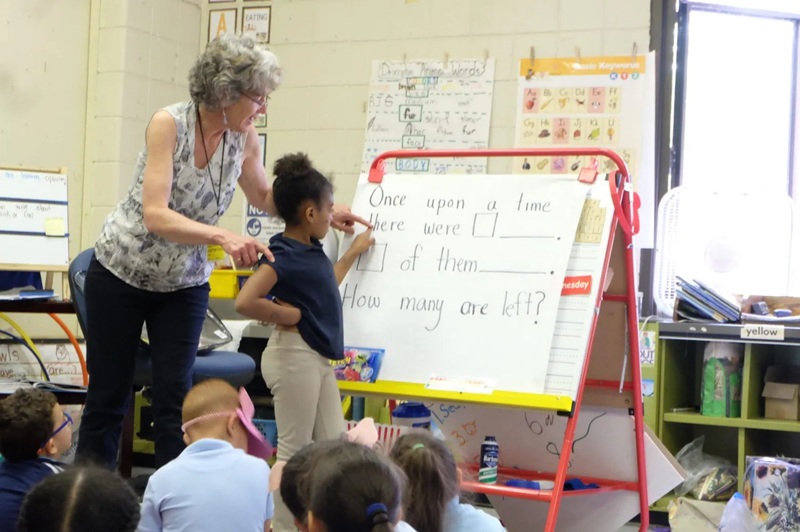Massachusetts has a literacy problem. We ignore it at our peril.

The Bay State has the second largest achievement gap between rich and poor students, a gap that has widened since 2019
A kindergartner at the Kelly School in Holyoke reads from an assignment as Enchanted Circle teaching artist Kate Carreiro looks on. (Photo by Sarah Betancourt) Credit
HE LATEST RESULTS of the National Assessment of Educational Progress, known as the “nation’s report card,” on our students’ achievement in reading and math were sobering, but not surprising. We are being heralded by Massachusetts education policymakers for being #1 in the nation in terms of academic achievement. But Massachusetts also holds the cringeworthy distinction of having the second largest achievement gap between rich and poor students, a gap that has widened since 2019. In spite of 30 years of reform efforts and tens of billions of dollars in increased spending, we are still only “#1 for some.”
Six out of every ten children in Massachusetts cannot read or do math at grade level. Eight out of ten low-income, Black and Latino children are not performing at grade level, leaving our state as a national leader in producing reading gaps for our Black and Hispanic students. Only half of white children are proficient. Needless to say, we should not be proud of our performance.
Parents should be outraged, but recent surveys conducted by the MassINC Polling Group indicate that they are generally satisfied with their children’s education. It will take bold leadership at the state and local levels to expose our accelerating achievement gaps and build support for changing literacy instruction to improve outcomes for the students who need it most. (MassINC Polling Group is partly owned by MassINC, the publisher of CommonWealth Beacon.)
Massachusetts is one of only 10 states that does not mandate evidence-based reading practices in schools. Additionally, the Commonwealth’s teacher prep programs are not preparing our new teachers with the skills to teach reading effectively. Almost 70 percent of the state’s higher education preparation programs are teaching practices that run counter to the research about what works best for students.
It is as though an alarm keeps ringing, yet we keep hitting snooze. As the ringing gets louder, the stakes get higher, and still our children wait for the adults in our state to wake up and act.
Not learning how to read has lifelong consequences. Students who are not reading at grade level by the time they reach fourth grade are four times more likely to drop out of high school which in turn leads to additional challenges for them as adults: lower lifetime earnings, higher rates of unemployment, and a higher likelihood of entering the criminal justice system. The impact of low literacy rates in our state will have sweeping economic and social consequences.
Massachusetts is being outpaced by Louisiana, Mississippi, and Tennessee — states that have mandated curriculum changes as a requisite for additional funding. These states are seeing a rebound in literacy scores, while Massachusetts students are falling further behind. Since 2013, we have seen a 71 percent increase in education spending to an average of $24,900 per student. Yet our children’s reading scores are significantly lower. If what we are buying isn’t working, shouldn’t we shift this investment to a proven method of teaching literacy?
Legislation recently filed (SD.1761 / HD.2329) — the “Right to Read Act” filed by Assistant Senate Majority Leader Sen. Sal DiDomenico, Democrat of Everett, Rep. Danillo Sena, Democrat from Acton, and Rep. Simon Cataldo, Democrat from Acton — would create a comprehensive framework for early literacy instruction, as well as implement the best, evidence-based solutions to improve children’s reading levels.
This would be done via providing pre-service training and professional development, offering assessment and parental notification, improving instruction and curriculum, and instituting tiered in-class and out-of-class intervention. It would also better support teachers’ capacity from teacher preparation to when they become solely responsible for their own classrooms, require high-quality curriculum materials aligned with the best science, and mandate support for students with dyslexia and multilingual students.
Governor Healey’s FY26 budget includes increased funding ($25M) for her Literacy Launch initiative, a multi-year program that provides districts with funding for high-quality, evidence-based reading instruction through literacy materials, technical support, coaching and professional development for educators. The Governor is also requesting funding ($25M) for high-dosage tutoring to build students’ early literacy skills.
Parents support science-based reading instruction — 8 out of 10 parents believe Massachusetts schools should be required to use evidence-based reading curricula.
Our coalition includes parents, former teachers, researchers and advocates across our Commonwealth. Our children attend our public schools. We care deeply about our state. It’s time to awaken from our slumber and act with urgency to improve reading results.

Our children’s future depends on us.
The Mass Reads Coalition is a group of educators, parents, literacy experts, and policy advocates that supports “Right to Read” legislation that would require school districts to use “evidence-based” literacy curricula.
The coalition includes Black Advocates for Educational Excellence, Decoding Dyslexia MA, Educators for Excellence MA, Give Black Alliance, Hill for Literacy, MassPotential, Latinos for Education MA, Massachusetts Business Alliance for Education, Massachusetts Charter Public School Association, National Council on Teacher Quality, National Parents Union, TeachPlus, Teach for America MA, The Education Trust MA, One Holyoke Community Development Corporation, NAACP Boston Branch, ExcelinEd in Action, He is Me, and The Reading League of MA.
